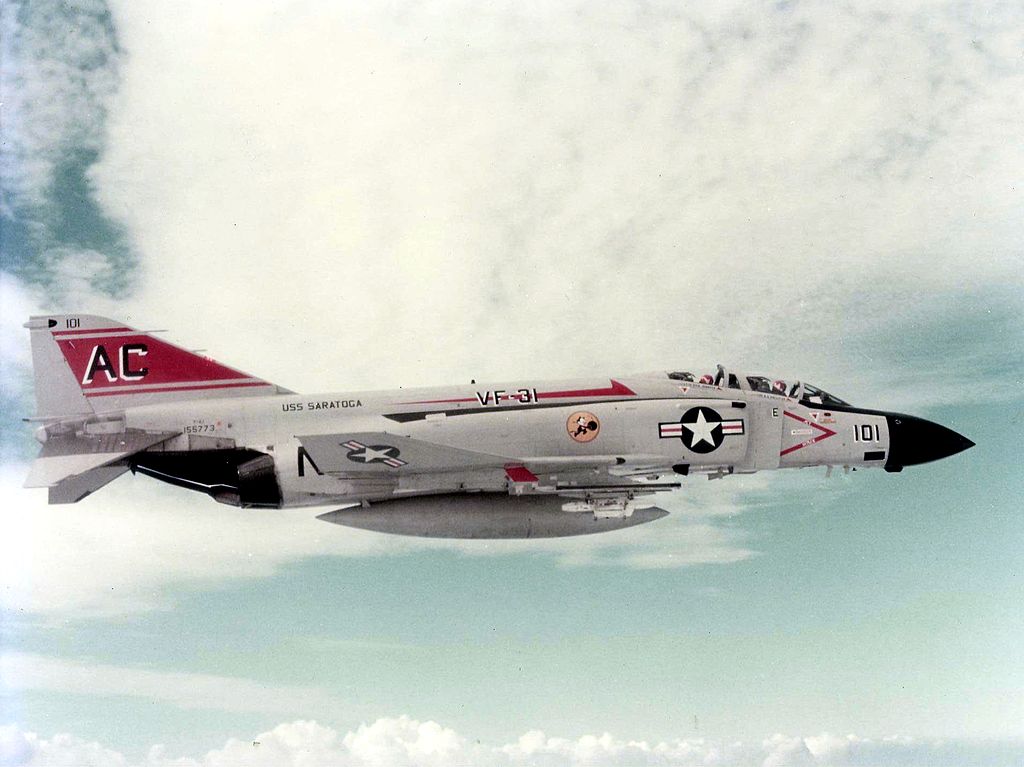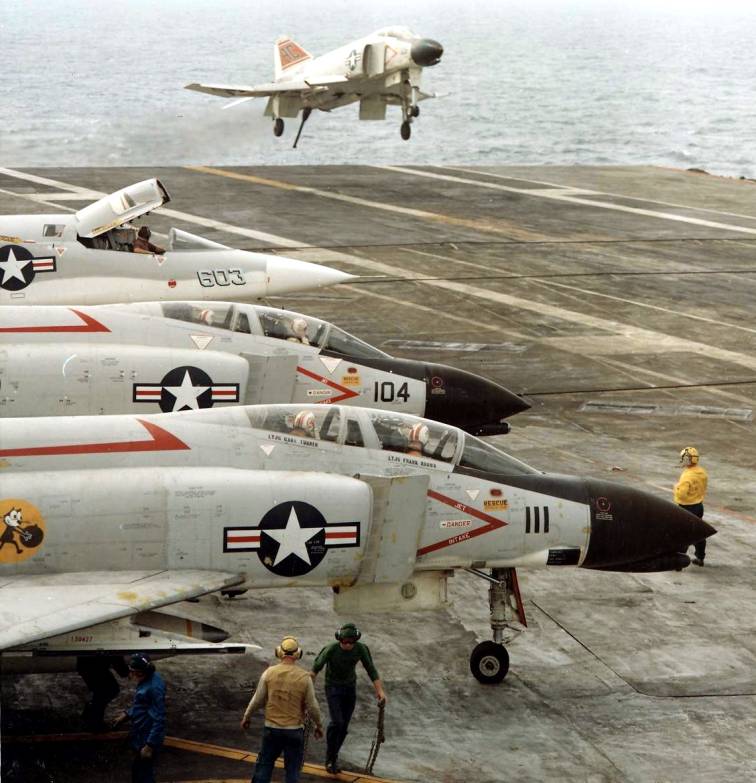“It was like something out of the old days. We had a standard Mark One dogfight as if it were right out of WWII. If you could have spoken to the Red Baron, of WWI fame, he could have probably told you some of the maneuvers we used,” Sam C. Flynn, former F-4 pilot
Despite being phased out of the Navy and Marine Corps, the F-4 Phantom II’s history is filled with innumerable accomplishments and successes in combat. The fight between an F-4 Bureau Number 157307 and a MiG adversary aircraft on Yankee Station off the coast of Vietnam on June 21, 1972, is described in the following story, headlined F-4 MiG Killer, written by then JO2 Julius L. Evans and published in the May-June 1989 issue of Naval Aviation News.
Saratoga (CV-59) had been on duty for several months prior to being diverted from her initial deployment to the South China Sea.
Saratoga had just finished her operational readiness-required workups in preparation for the impending Mediterranean journey, although East Coast carriers don’t typically do Western Pacific cruises. She was the ready carrier and was berthed in Mayport, Florida. The crew of the Saratoga was prepared, as all carrier crews are urged to have their seabags ready to detach earlier than intended if necessary. There was not much time left before departure for the Mediterranean.
The necessity emerged suddenly.
Following the conclusion of at-sea workups, Saratoga had 30 days to prepare for deployment. Some crew members took leave and left the area as the ship was being prepared for her imminent deployment to the Mediterranean, while others opted to spend the last few weeks with their families before the men in white manned the rails as the ship returned to deep water operations.
It was the “Phantom Fling” night. The officers and their wives were ready for the gala, which typically attracted the most fighter squadron members who weren’t on deployment. For some of the spouses, finding the ideal clothing took a lot of time, and in preparation for the celebrations, last-minute tailoring was done on a few of the white mess dress uniforms.
The combat in Vietnam, which was thousands of miles away, was getting worse. Many Americans underestimated how difficult an enemy the Vietcong would be. A West Coast carrier was unable to deploy as planned because more power was required at Yankee Station at the last minute. The Joint Chiefs of Staff made their choice without delay. To expand operations, Saratoga would be directed to the Western Pacific.
While the “Fling” was in full swing back home in the United States, commanding officers were told in whispers that Saratoga was to deploy right away. It came as a complete shock. Nobody anticipated deployment in an emergency. The radar intercept officer (RIO), who later flew in Phantom 157307 during the MiG mission, Lieutenant Willian H. John, recalled that once we received notice, we had roughly 72 hours to start moving. “That involved transporting supplies and employees from Oceana, Va., to Mayport, Fla., and preparing the ship with all we required for a Westpac journey.

“We stayed up all night calling everyone back from leave,” John said. “Some personnel had to meet the ship at sea. It was quite an involved process to get everyone back on board and get underway, but we were steaming well within our allotted time.”
Flight activities accelerated once Saratoga arrived at the station and allied with USS Kitty Hawk (CV-63). The executive officer of VF-31 and pilot of the MiG mission at the time, Commander Sam C. Flynn, remarked that “we were on the front line flying combat missions from May until June.”
Cdr. Flynn and Lt. John piloted Phantom 157307 as they guided the MiG Combat Air Patrol (MiG CAP), which was made up of two Phantoms. Their task was to fly under the protection of an A-6 Intruder and an A-7 Corsair II strike force attack aircraft, both of which were tasked with attacking objectives between Haiphong and Hanoi.
The MiG CAP was instructed to take up position between the strike force and the airfield where MiGs were most likely to originate. When the USS Long Beach (CGN-9), the MiG CAP’s control ship, reported that MiGs were airborne, the leading aircraft had just finished in-flight refueling.
“We ingressed over an enemy territory about five minutes before the strike force,” Cdr. Flynn said. The ground crew began firing surface-to-air missiles (SAMs) at the two F-4s as soon as they crossed ridgelines. When Long Beach directed them north to the MiGs, which were 15 to 20 miles distant, they had just managed to avoid the missiles’ course.
Prior to making visual contact with the MiGs during the run-in, the Phantoms were free to fire. The F-4s were unable to see the MiGs on their radar because they were flying higher than expected. Lt. John explained, “After maneuvering against the SAMs, we came in at about 7,000 feet and expected the MiGs to be below us. They were actually well above us.”
According to Cdr. Flynn, when the Phantom met the MiGs, “It was like something out of the old days. We had a standard Mark One dogfight as if it were right out of World War II. If you could have spoken to the Red Baron of WWI fame, he could have probably told you some of the maneuvers we used.”
The wingman started the fight, but the Phantom was at a disadvantage because the MiGs were coming in from overhead. “Our wingman who had the initial tally was unable to achieve an engaging position, so we took the offensive and came behind the lead MiG’s wingman,” Lt. John said.

“When we went high, we followed him, and after a series of loops, turns, and high-speed maneuvers, we locked up the MiG and attempted to fire a Sparrow missile, but it malfunctioned on the aircraft.”
The lead MiG was preparing to fire an Atoll, the Soviet version of a Sidewinder, as it maneuvered behind our wingman. “We had the advantage on our MiG, but after the missile malfunction and switching to Sidewinder, I came out of the cockpit,” Lt. John said, referring to looking out of the cockpit instead of using radar. “Knowing where our wingman should be—10 o’clock high in that a MiG was at his 7 o’clock and pulling lead to fire—I told Nick, our wingman, that he had a MiG at his 7 o’clock who was firing and called Sam off the MiG we were engaging and told him that our wingman was at 11 o’clock high. Sam immediately broke off the chase.”
By the time the lead Phantom arrived, the wingman had dodged two missiles. “Sam told him to keep pulling on the stick and to keep it in the afterburner because the MiG was still at his 7 o’clock,” Lt. John said. Although his wingman was too close to his line of fire, the lead Phantom was able to establish a good firing position on the MiG. “I didn’t know if the missile would guide on the Phantom or the MiG, so I fired a Sidewinder off to the right, hoping that the MiG would turn around to engage me,” Cdr. Flynn continued.
Cdr. Flynn understood that he didn’t have much time to remain inside the Sidewinder envelope since the MiG may outturn the Phantom. “I was about 45 degrees off his tail and realized that he was going to be out of the missile envelope real soon,” Flynn said. A third missile was launched by the MiG at the wingman. When the wingman abruptly drew back, the MiG yo-yoed high, allowing Phantom 157307 to slam into the back of the MiG.
“Once we got in position, we were able to fire two additional Sidewinders at him. The first missed, but the second went right up the tailpipe and blew off part of the empennage, Lt. John recalled. “He went into a flat spin and tried to recover a couple of times, eventually ejected at about 1,000 feet.”
Although the entire action only lasted for about a minute and a half, the Phantom 157307 aircrew will likely remember the adventure for the rest of their lives. “The opportunity to successfully engage in combat instills a feeling of accomplishment,” Cdr. Flynn stated. “You’re honed right to the razor’s edge after 24 years of training for this event; you could say a sense of self-satisfaction sums up everything.”
Lt. John added, “This was like the graduation of all my training. It was an exhilarating experience that very few pilots or radar intercept officers get the opportunity to go through.”

For their gallant efforts, they each received the Navy Silver Star.
Photo by U.S. Navy

